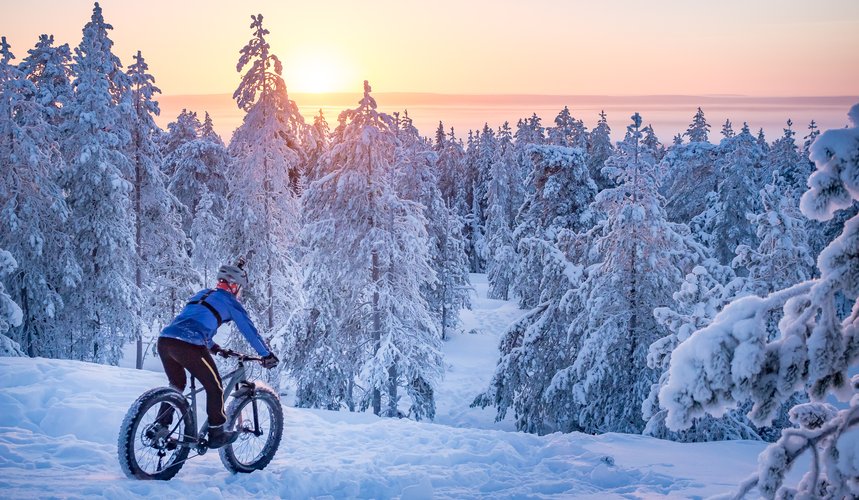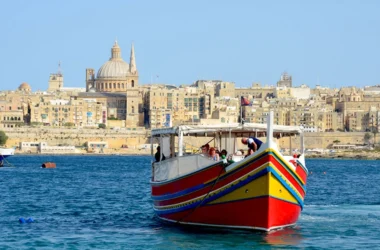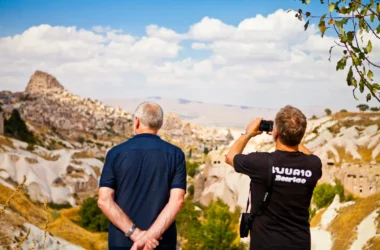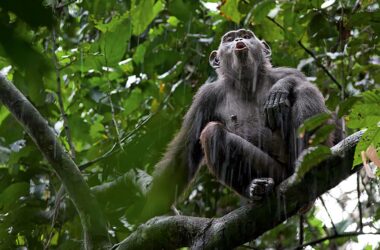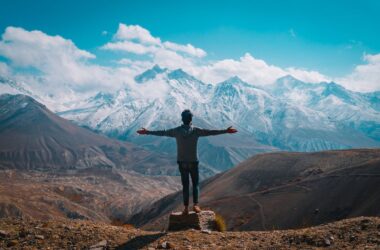If you fancy fat biking in Finland, head to Oulanka National Park and get ready to make some serious tracks in the snow. These mountain bikes with big chunky tyres are a great way to enjoy some Arctic exercise and have fun as part of a small guided group without damaging the environment.
FAT BIKING IN FINLAND
There aren’t many jobs for young Finns living in and around Oulanka National Park in Lapland, especially in the dark depths of winter. Positions at local ski resorts are only seasonal and usually result in standing in the freezing cold manning a ski lift for hours on end. It’s boring, dead-end work and not very well paid. That’s why many head to Helsinki or even further afield. Kuusamo Airport is just 50km from the village of Juuma in Oulanka and makes a convenient escape. Few will return.
One alternative source of income can be found at the award-winning eco-lodge, Basecamp Oulanka. This oasis of employment is fast gaining a reputation as an international activity center. Small groups of guests come from far and wide to spend a week amidst the Arctic wilderness. They can take part in lots of traditional outdoor activities and new ones too, like fat biking. This is basically a mountain bike with big chunky tyres that allows you to cycle over compact and powder snow, through wild taiga forests and around vast frozen lakes.
Training as wilderness guides, activity instructors and center staff offers work for local people throughout the year. This also encourages Finns to share their passion for the environment and traditions that have been passed down through the generations.
Keijo Salenius is the founder of Basecamp Oulanka and works in partnership with our small group winter tour specialists, Exodus Travels: “Young kids in Finland often have to go far away to find work. There are no universities or educational opportunities for them around this area. It’s a sad thing as not many return home. Some, also, go to work on the local ski resorts. They often get bored just standing by the ski lift station. It’s not much fun. We offer them a different type of work as wilderness guides. A job that is more rewarding and totally different. They get trained at a local wilderness school and then learn more, here, with us.”
New recruits also become skilled in activities like fat biking. This relatively new mode of transport in Finland is purely recreational but still in keeping with traditional winter activities such as husky sledding, snowshoeing and cross country skiing. There’s minimal disruption to the natural peace of the snow-covered wilderness and you get a healthy dose of exercise even in Arctic temperatures.
“Fat biking allows you to really get into nature,” says Keijo. “The silence can be scary as well as mystical. You can’t hear anything other than the blood running through your veins. Not even the wind. People don’t anticipate this. Often our guests have 24-hour stress when they arrive. They’re afraid of everything. Then they learn to relax and become more of a part of the wilderness. They learn to feel safe. There is nothing that can harm them here. No snakes, no lions or crocodiles. They’re in safe hands.”
Local knowledge
The sort of local knowledge that comes from living in the same area and listening to tales from your grandparents around an open fire is something that can’t be bought. Winter, especially, really takes some getting used to. Temperatures can drop to -30°C. This is not the time of year to be wandering off into the wilderness without someone who knows what they’re doing.
Local wilderness guides know where to find animal tracks, how to keep warm, and the difference between a quinzee, a lean shelter and an igloo. Clue: you can’t make an igloo in Finland – the snow isn’t hard enough. You can sleep outside in a lean shelter, though. A little fire out front and the dark winter’s sky above – pure Arctic magic.
Finns understand and respect nature, especially those living in remote rural areas. They share many of the same traditions and stories as Sami people. Hunting and handicrafts, for example, are based on nature. Nothing gets wasted. The skin, meat and bones of animals are all used in different ways. As far as they’re concerned, if you’re killing an elk or reindeer to eat because there’s no supermarket or local butchers, surely it makes sense to use the entire animal rather than throwing half of it away? It’s possible to purchase authentic locally made crafts at the lodge or you can try your hand at making your very own shamanic drum from reindeer hide.
Keijo Salenius, the eco-lodge founder who works in partnership with our winter tour specialists Exodus Travels, says: “We only eat elk meat which has been hunted and killed within the authorised time of year – October to December. The authorities will come round and check that this is the only meat in our freezer. This system is in place to ensure the elk population remains healthy and allows Finnish hunting traditions to also continue.”
Making tracks
A week of fat biking as part of a small guided group is a great activity to try whilst staying at a lodge. Cycling with a local guide means you can make the most of the snow-covered pine forests and vast frozen lakes without worrying about getting lost. You’ll follow tracks in the snow created by husky sleds, snowshoes and snowmobiles. Cold weather gear is provided and the group will be briefed with safety instructions before setting off. It’s a good way to make new friends, get some exercise and experience life in the Arctic wilderness. Also, it’s much less damaging to the environment than downhill skiing.
Fat biking itself is very straightforward and routes take you along the edge of the Oulanka River to the Russian border overlooking Lake Paanajärvi. Keep an eye out for elk, reindeer, wolverines and golden eagles. Most days will conclude with a steaming bowl of elk meat stew around the log fire followed by a sauna and semi-naked roll in the snow – this is the best way to keep clean, apparently. Although there are also hot showers as well as under floor heating.
Keijo Salenius says: “Animal tracks are also easier to spot in the snow. You get to understand the relationships between different species in a way that it would be impossible to do without snow. For instance, the otter and the wolverine play a game together. People know that otters slide on their bellies but wolverines do this too. It would be impossible to know this without seeing the tracks of both animals in the snow. Lynx tracks are rarer to see but golden eagles can sometimes be sighted overhead. Eagles are one of only 20 species of birds to be able to survive the winter. The rest either die or migrate south.”
Sustainability in the snow
“My own mother’s attitude to sustainability is: don’t buy anything and you will be living a sustainable life,” says Keijo. “This way of doing things is possible. We only eat local food, no tins or plastics, just simple produce. We don’t let quick cook food into our kitchen – it’s too fast, the modern style, not healthy for people or the environment.”
Another area where the lodge excels in sustainability is clothing. Rather than encouraging guests to buy their own expensive cold weather gear there’s plenty of warm clothing to borrow when you arrive. Clothing gets used again and again. This is especially great for visitors with kids because, realistically, how often are they going to get dressed up in extreme Arctic gear when they get back home – they’ll have grown out of it in six months and then what are you going to do with it?
Environmental issues
Everything in Oulanka National Park in the winter is based around the snow. If there were no tracks to follow from fat bikes, husky sleds or snowshoeing, walkers would get lost. But climate change is making the weather unpredictable. It used to be that snow would fall like clockwork in October. Now you might have to wait until November, or sometimes even December. As Keijo explains, “The funny thing is that local people are very happy that winters are getting warmer. When you’ve experienced -35°C for three weeks you’d understand. There is a big difference from -35°C and -25°C, a big difference. -25°C is not actually very bad. It’s quite comfortable. With the right clothing, of course.”
Once the snow has set in, you can’t predict what will happen from one day to the next. It usually snows until May but sometimes it comes in very cold cycles followed by blue skies. Temperatures can be -30°C and then the next day at zero. The cold is always dry, though; this makes a big difference.Endemic animals, such as the Siberian jay, are also suffering. These birds are one of the very few that can survive in the harsh depths of winter. They live in the ancient boreal forests and store food inside old spruce trees. The change in climate has greatly affected spruce trees in Finland and many indigenous forests have also been thinned or replaced with pine by the forestry commission. If the spruce disappear then so do the Siberian jays, it’s as simple as that.
Staying at the lodge for a week in winter allows you to appreciate the beautiful silent forests of Finland from a Finn’s perspective. Their passion for the environment and tradition are key factors in how we can help to preserve the natural landscapes for many more years to come. Fat biking may be a modern activity but it’s as low impact as snowshoeing or cross-country skiing. All you have to do is get up and go. Now where did I put those thermal long johns?
